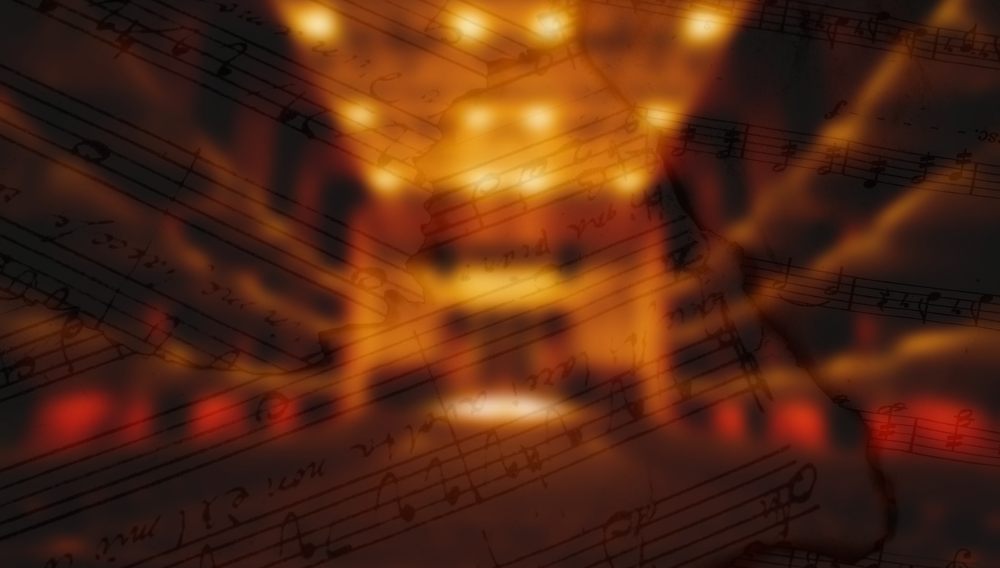
Some reviews “write themselves.” A theme seems to emerge without effort, the lead unfolds like a paper flower in hot lime-flower tea.

Other reviews require some or a lot of thought to come into focus. Others never do. Fragments of what was seen and heard lie on the card-table like the bits of a 1000-piece jigsaw that came without a box.
There may be a picture hiding here, but the only sure thing is that you don’t see it. What follows are some of the more coherent impressions of what turned out to be a thoroughly incoherent evening.
The audience for the first of two “special holiday baroque” concerts at Benaroya Hall was encouragingly numerous, considering the foul weather and the late hour, though because seating was confined to main floor and first balcony, less numerous than it looked.
Sitting for the first time I can remember away from my favorite place on the acoustic sweet spot “second tier,” I wondered whether the sound would be appreciably different in seat A1 Right.
Reading the program and its copious three columns of notes, I wondered about the “baroque” label. Apart from the opening palate cleanser, a three-minute fragment of Handel for contralto and solo trumpet snipped from the opening of a Handel ode for Queen Anne’s birthday and some of the more familiar Christmasy bits of his Messiah, the bulk of the music was solidly “classical.” Even the Messiah excerpts were taken from Mozart’s dubious re-orchestration designed for private performances in Viennese households which found the original too austere and scrawny-sounding.
Scrawny certainly seemed a just description of the band assembled for the show: A reduced force of string players huddled together on a stage where we’re used to seeing 50.
Once SSO associate conductor Lee Mills gave the downbeat, scrawny seemed over-generous. The ensemble’s sound seemed to emerge from a muffled indeterminate source hovering over the audience. It felt as if I was wearing ear-plugs.
Could the acoustics of Benaroya’s “Founder’s Tier” possibly be so wretched? Was the seat I occupied one of the dead spots I’d heard sbout from time to time since the hall opened? Or had my hearing suddenly degenerated since my last live visit just five weeks earlier?
Whatever the reason, I spent the next while in auditory Limbo. Sherezade Panthaki deployed her lovely liquid soprano through a misty sieve. Tenor Zach Finkelstein, boasted veteran of 32 full-length Messiahs with 14 ensembles over five seasons, seemed to emit only a pitchless rasp in a mid-voice which emerged to barely audible sweetness in the higher passages of “Comfort ye” and “Ev’ry valley.”
When sounds fails one in the concert hall, the mind is left to wander.
- Why on earth was the tiny fragment of Handel opening the program followed immediately with the most inexplicable 10 minutes in Western music, Mozart’s ugly, ill-natured c minor adagio and fugue for string quartet?
- After the Messiah assortment, why was the remainder of the evening devoted to two 20-minute long symphonies?
- If two symphonies, why pair a piece by a 21-year-old Mozart with one by the 63-year-old Haydn? Mozart’s “Paris” symphony is considered one of his first “mature” works, but mature isn’t quite the same thing as “good”. The Haydn is only one of a sunburst of 12 masterworks written by a composer at the peak of his powers when Mozart was already in his grave.
- And why on earth stick a 20-minute intermission between the two before sending us off cheerless into the chill and the wet?
Under the circumstances it is difficult to make any assessment of conductor Mills’ contribution to the program. I do think it is justified to question the judgment which allowed such a drab exhibition to be presented as a celebration of the season.
Discover more from Post Alley
Subscribe to get the latest posts sent to your email.

Roger raises the forbidden question of how good are Benaroya’s normally-praised acoustics. A plus, to this listener’s ears, is how velvety is the silence in the room. Another plus is the small overhang of the boxes and balconies, so the sound under them is not deadened. (The tradeoff is the unusual length of the hall, so the rear seats are very far visually from the stage.) A novel factor in the design by New York acoustician Cyril Harris are the reverberating, oddly-sized panels lining the walls, meant to vibrate and therefore take out some of the bass. Roger is right that the best sound is upstairs, particularly in the rows that get bounce from the rear and side walls. In the orchestra level, the sound can tend to pass over your head and get “misty.” The general tuning, as is common today, is toward the bright, CD-sounding end of the spectrum, meant to emphasize the brass and high notes.
After half-a-century of reading, dating back to “Katims: The Man and the Mess,” I have not tired of Roger Downey’s symphony reviews, the laudatory and less so. With near disappearance of criticism in this town, let us hear more.
Have to agree the last half of that program was of minimal interest, and hardly fit the season, but what lingers still is that voice – Sherezade Panthanki’s soprano giving life to Handel. Worth the ticket price and then some.